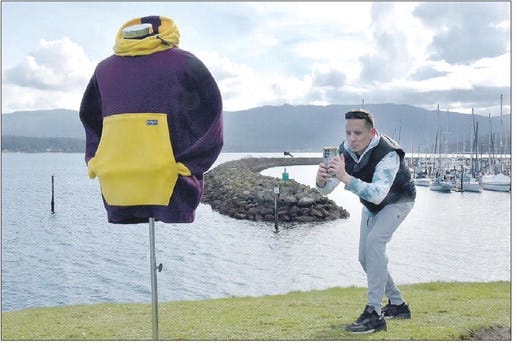Why does it matter?
A question of equity, identity, and media consistency
Three everyday photos, three everyday people, and one subtle detail that caught the attention of sharp-eyed readers. What was it? You might not notice at first glance—but once you do, it raises a bigger question about how identity, equity, and media framing intersect in our community.
Take a look at these three photos featured on the front page of recent Peninsula Daily News editions, and the captions that were printed below them. Several CC Watchdog readers noticed something curious—something that raises a deeper question about how our local media chooses to frame identity.
Shanna Bloom, who lives at the intersection of Fifth and Cherry streets in Port Angeles, plans to keep her American flag lights up well into spring. “These aren’t Christmas lights anymore,” she said. “They are patriotic lights now.”
Parker Brocious, 6, from Cedar Hills, Utah, studies tubs containing plankton, krill and other small ocean creatures used by the Port Townsend Marine Science Center for education purposes while on a road trip with his family on Tuesday at Fort Worden State Park. Parker’s father Tyler is at left.
Joseph Prince takes a photo of a hoodie jacket on Wednesday on a small hill overlooking the entrance to John Wayne Marina near Sequim. Prince, a member of the Jamestown S’Klallam Tribe, said the weather was ideal for adding items to the catalog of his online vintage clothing business.
We know the names of the people in these photos: Shanna, Parker, and Joseph. We know where the photos were taken: Port Angeles, Port Townsend, and Sequim. We know what each person is doing: hanging lights, looking at plankton, and photographing clothing. All fairly ordinary moments.
But here’s what caught the attention of many: Why does it matter that Joseph is a member of the Tribe?
That’s a good question.
In a society that is supposed to judge people by the content of their character—not the color of their skin or their cultural affiliation—why would the newspaper of record go out of its way to highlight a person’s tribal membership in a photo caption, especially when that detail has nothing to do with the subject of the photo?
Would it be appropriate to say, “Miguel Hernandez, a Mexican, was windsurfing off Cline Spit”? Would the PDN ever publish, “Nguyen Do, a Vietnamese, attended the Irrigation Festival with his family”? Would readers find it odd—or even offensive—if a caption read, “Jessica Walters, a Republican, enjoys coffee on Railroad Avenue”?
As Clallam County Commissioner Mike French has pointed out, Tribal affiliation is not a racial classification. It is a political one—rooted in legal recognition of sovereign governments. So, if the argument is that race should not be a basis for differentiation, what are we to make of selective tribal labeling in contexts where it offers no relevant insight?
Let’s be clear: there are many situations where a person's identity, heritage, or political association is relevant to the story. If a Tribal elder is speaking on land rights, if a cultural celebration is being documented, or if a local Native business is participating in a community initiative—then yes, their tribal affiliation provides context and depth. It belongs in the story.
But photographing clothing on a hill? That’s not a cultural moment. That’s a personal one. Adding Joseph’s tribal affiliation doesn’t enhance our understanding of the photo—it only raises the question of why it’s there in the first place.
There are two plausible reasons. One, the editor or photographer wanted to highlight Native presence in everyday life, perhaps as part of a broader goal to improve visibility. That’s not inherently bad—but it risks slipping into something else: performative representation. The inclusion feels less like meaningful acknowledgment and more like box-checking.
The second possibility is more troubling: that some identities are treated as inherently newsworthy, even when irrelevant to the story, while others are routinely ignored. That’s not equity—that’s editorial inconsistency.
Selective labeling doesn’t make us a more inclusive society. If anything, it creates a new hierarchy—where some affiliations must always be acknowledged and others are deemed unimportant or even invisible. Ironically, this reverses the very imbalance modern equity movements claim to address.
Equity isn’t about giving one group a permanent spotlight. It’s about treating everyone fairly under the same rules. That means recognizing identity when it matters—and stepping back when it doesn’t. It means resisting the urge to highlight race, ethnicity, or political classification just to look inclusive. Because when we do, we risk reducing individuals to symbols instead of seeing them as people.
Media matters. Language matters. Consistency matters.
The Peninsula Daily News didn’t mention Shanna’s political beliefs or Parker’s religion. It didn’t tell us whether Joseph was a Democrat or a Republican. It did tell us he was a Tribal member—without giving us any reason why that fact was relevant.
If we want a truly equitable media landscape, then our standards need to be consistent, not selectively applied. We don’t need to pretend we’re colorblind—but we do need to be conscious of when and why we’re calling attention to someone’s identity.
Because if we can’t answer the question “Why does it matter?”—then maybe it doesn’t.
Last Equitable Wednesday, readers were asked if they think that excluding prospective employees based on their race or heritage harms the overall goals of environmental conservation. Of 223 votes:
97% said, “Yes, it limits the talent pool.”
3% said, “No, a focus on tribes is needed.”







Great observation. Too bad it takes a measurable quantity of guts and courage to shine a light on it, lest one be assigned the identity of 'Racist' by the Tolerant Left.
People will say this is race-baiting, as if there aren't writing-style guidelines that generally dictate these things.
Your “Why does it matter?” lens slices right to the heart of equitable storytelling: context should illuminate, not tokenize. When identity details appear without clear relevance, they shift from insight to ornament—and the audience is left wondering whose perspective the narrative is really serving.
Three threads your piece pulls into sharp focus:
1. Relevance Is a Responsibility
Identity markers can deepen understanding when they connect to the subject at hand (land use, cultural celebration, policy debate). Absent that link, they become a distraction—reminding us that inconsistency is its own form of bias.
2. Selective Labeling Breeds Mistrust
If some communities are named while others remain “default,” the subtext is loud: certain identities are still treated as qualifiers, others as invisible norms. That double standard erodes the very trust local media needs to hold power to account.
3. Equity Demands Symmetry, Not Silence
The answer isn’t to scrub stories of identity altogether; it’s to apply the same editorial rigor across the board. If heritage, politics, or faith are pertinent, spell out why—for every Shanna, Parker, and Joseph alike.
Thank you for raising the flag on subtle framing choices that ripple far beyond a single caption. Here’s to a community conversation—rooted in transparency and mutual respect—that makes our local storytelling stronger, fairer, and truer to the people it depicts.